Business Decision Making: Theories, Principles, and Techniques
VerifiedAdded on 2023/06/14
|7
|1458
|84
Essay
AI Summary
This essay provides an overview of business decision-making, including the calculation of payback periods and net present values for projects A and B of DD plc, a vegetarian food manufacturing company. It analyzes financial factors like capital structure, leverage, and liquidity, as well as non-financial factors such as government regulations, customer relations, and employee retention, which influence business decisions. The essay concludes that capital budgeting tools are essential for making sound investment decisions and ensuring the financial health of an organization, highlighting the importance of considering both financial and non-financial elements in the decision-making process. Desklib offers a variety of study tools and resources for students.
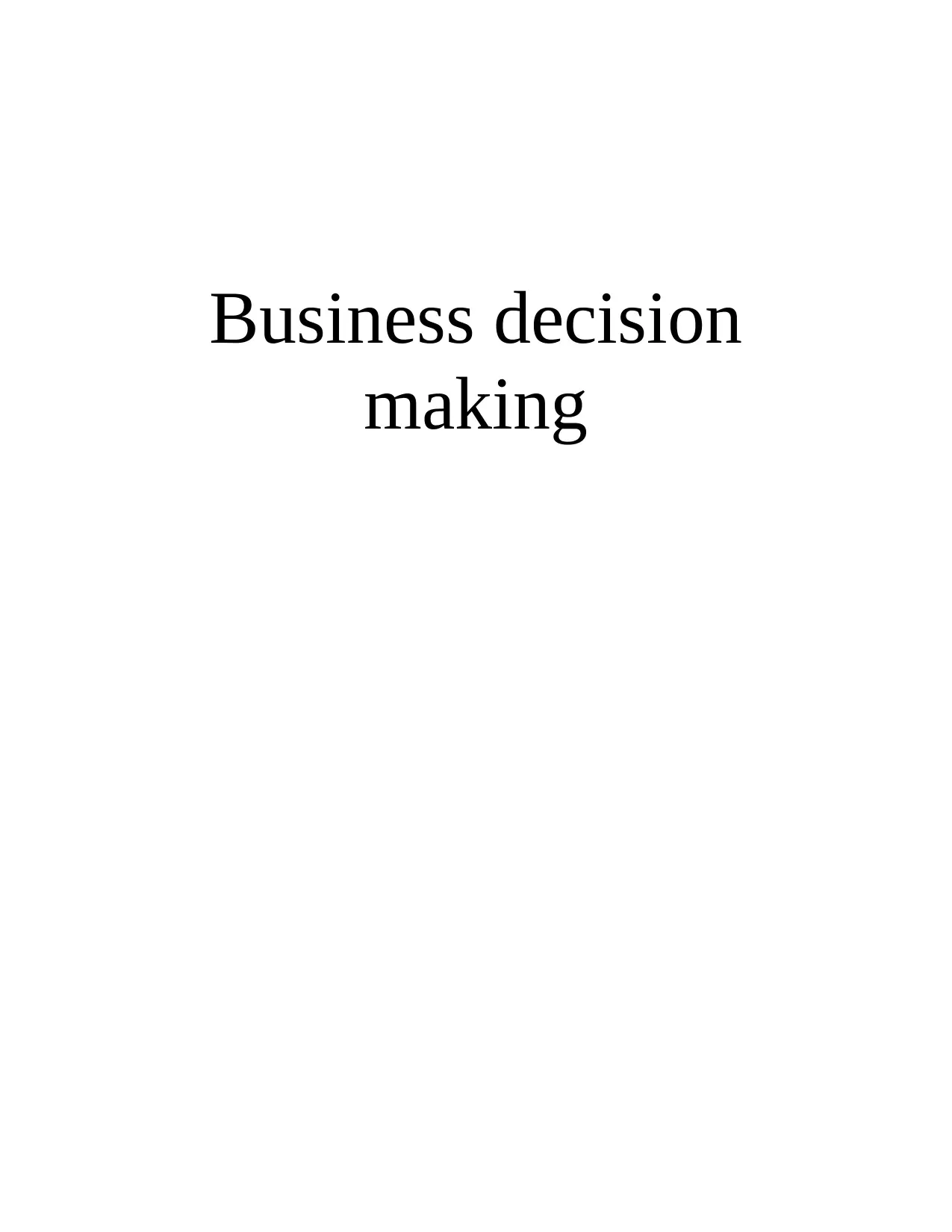
Business decision
making
making
Paraphrase This Document
Need a fresh take? Get an instant paraphrase of this document with our AI Paraphraser
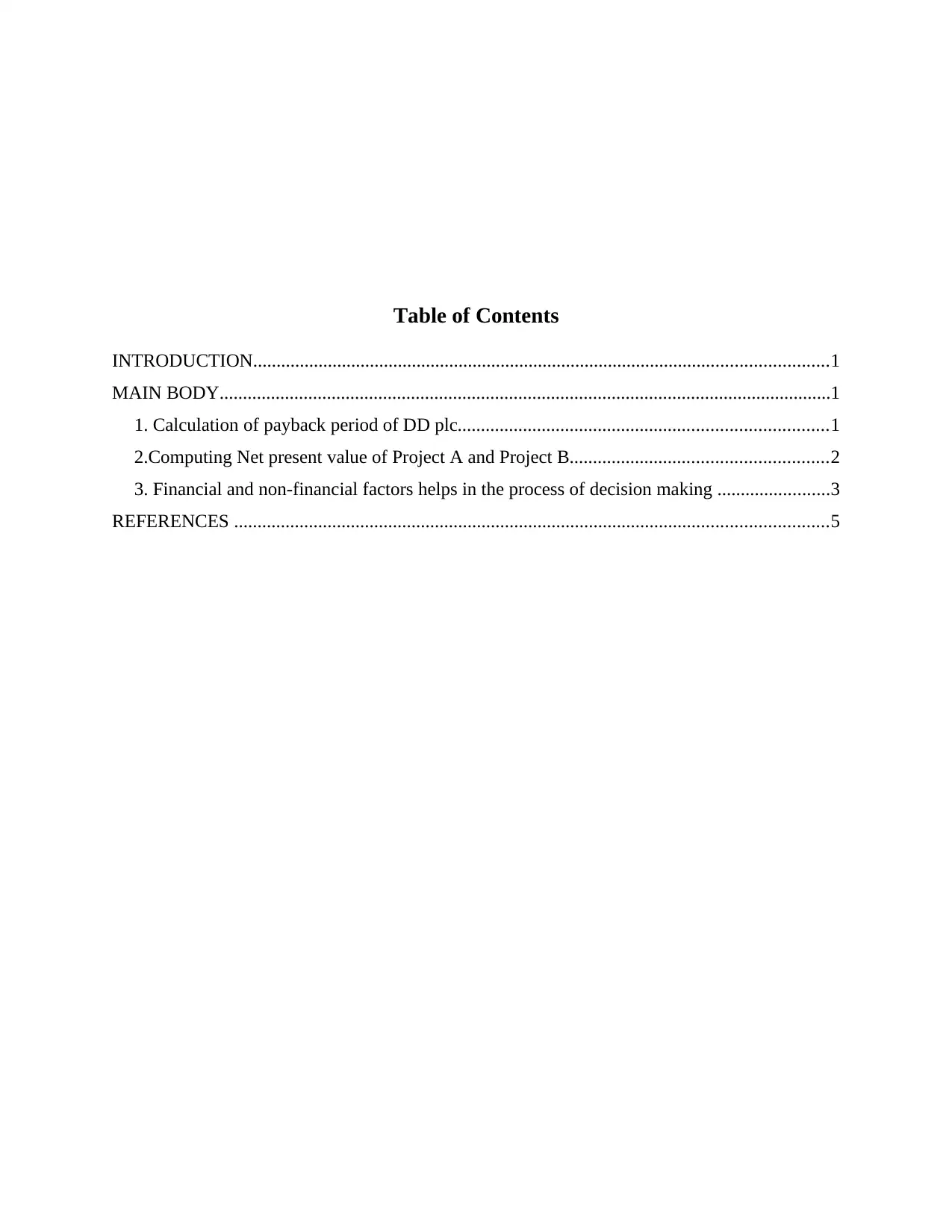
Table of Contents
INTRODUCTION...........................................................................................................................1
MAIN BODY...................................................................................................................................1
1. Calculation of payback period of DD plc...............................................................................1
2.Computing Net present value of Project A and Project B.......................................................2
3. Financial and non-financial factors helps in the process of decision making ........................3
REFERENCES ...............................................................................................................................5
INTRODUCTION...........................................................................................................................1
MAIN BODY...................................................................................................................................1
1. Calculation of payback period of DD plc...............................................................................1
2.Computing Net present value of Project A and Project B.......................................................2
3. Financial and non-financial factors helps in the process of decision making ........................3
REFERENCES ...............................................................................................................................5
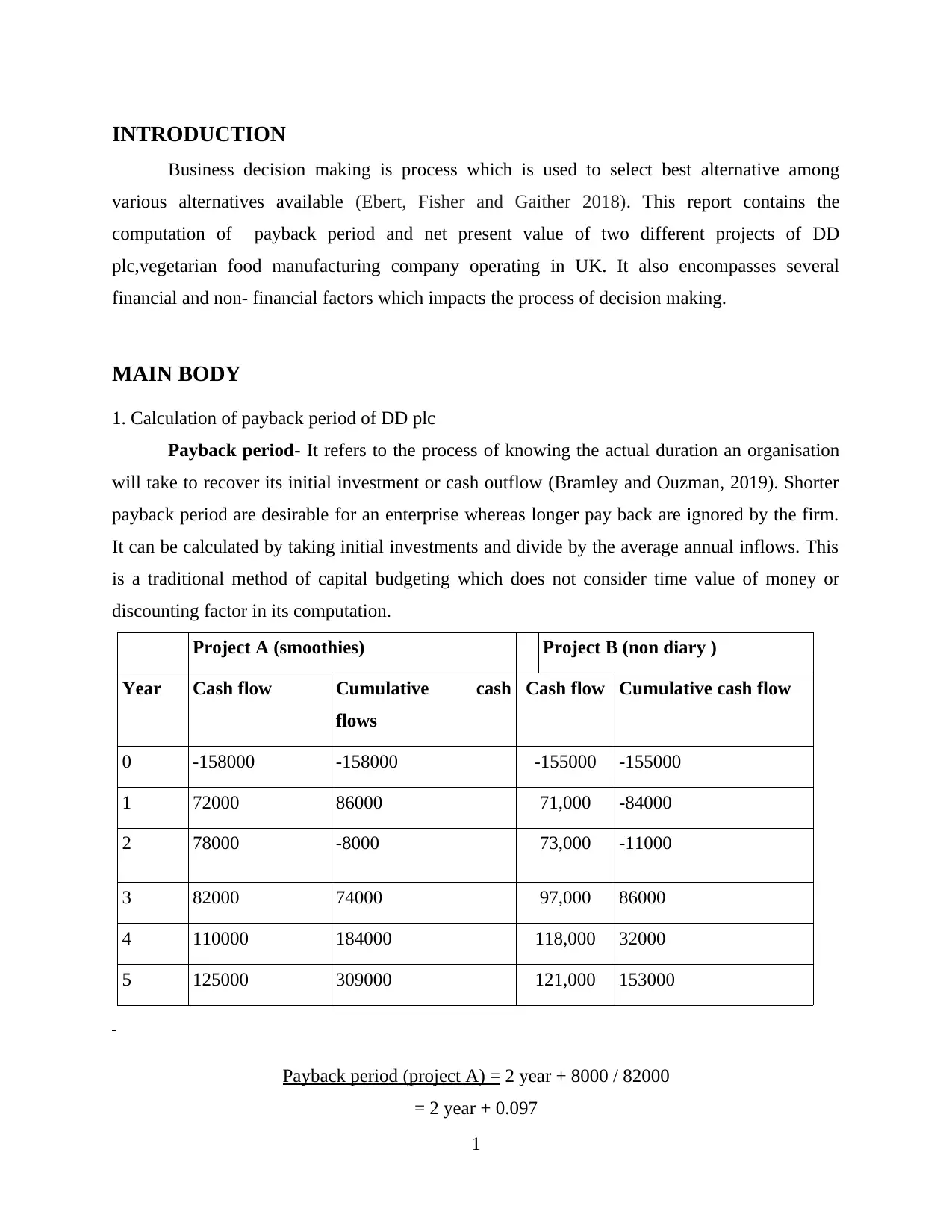
INTRODUCTION
Business decision making is process which is used to select best alternative among
various alternatives available (Ebert, Fisher and Gaither 2018). This report contains the
computation of payback period and net present value of two different projects of DD
plc,vegetarian food manufacturing company operating in UK. It also encompasses several
financial and non- financial factors which impacts the process of decision making.
MAIN BODY
1. Calculation of payback period of DD plc
Payback period- It refers to the process of knowing the actual duration an organisation
will take to recover its initial investment or cash outflow (Bramley and Ouzman, 2019). Shorter
payback period are desirable for an enterprise whereas longer pay back are ignored by the firm.
It can be calculated by taking initial investments and divide by the average annual inflows. This
is a traditional method of capital budgeting which does not consider time value of money or
discounting factor in its computation.
Project A (smoothies) Project B (non diary )
Year Cash flow Cumulative cash
flows
Cash flow Cumulative cash flow
0 -158000 -158000 -155000 -155000
1 72000 86000 71,000 -84000
2 78000 -8000 73,000 -11000
3 82000 74000 97,000 86000
4 110000 184000 118,000 32000
5 125000 309000 121,000 153000
Payback period (project A) = 2 year + 8000 / 82000
= 2 year + 0.097
1
Business decision making is process which is used to select best alternative among
various alternatives available (Ebert, Fisher and Gaither 2018). This report contains the
computation of payback period and net present value of two different projects of DD
plc,vegetarian food manufacturing company operating in UK. It also encompasses several
financial and non- financial factors which impacts the process of decision making.
MAIN BODY
1. Calculation of payback period of DD plc
Payback period- It refers to the process of knowing the actual duration an organisation
will take to recover its initial investment or cash outflow (Bramley and Ouzman, 2019). Shorter
payback period are desirable for an enterprise whereas longer pay back are ignored by the firm.
It can be calculated by taking initial investments and divide by the average annual inflows. This
is a traditional method of capital budgeting which does not consider time value of money or
discounting factor in its computation.
Project A (smoothies) Project B (non diary )
Year Cash flow Cumulative cash
flows
Cash flow Cumulative cash flow
0 -158000 -158000 -155000 -155000
1 72000 86000 71,000 -84000
2 78000 -8000 73,000 -11000
3 82000 74000 97,000 86000
4 110000 184000 118,000 32000
5 125000 309000 121,000 153000
Payback period (project A) = 2 year + 8000 / 82000
= 2 year + 0.097
1
⊘ This is a preview!⊘
Do you want full access?
Subscribe today to unlock all pages.

Trusted by 1+ million students worldwide
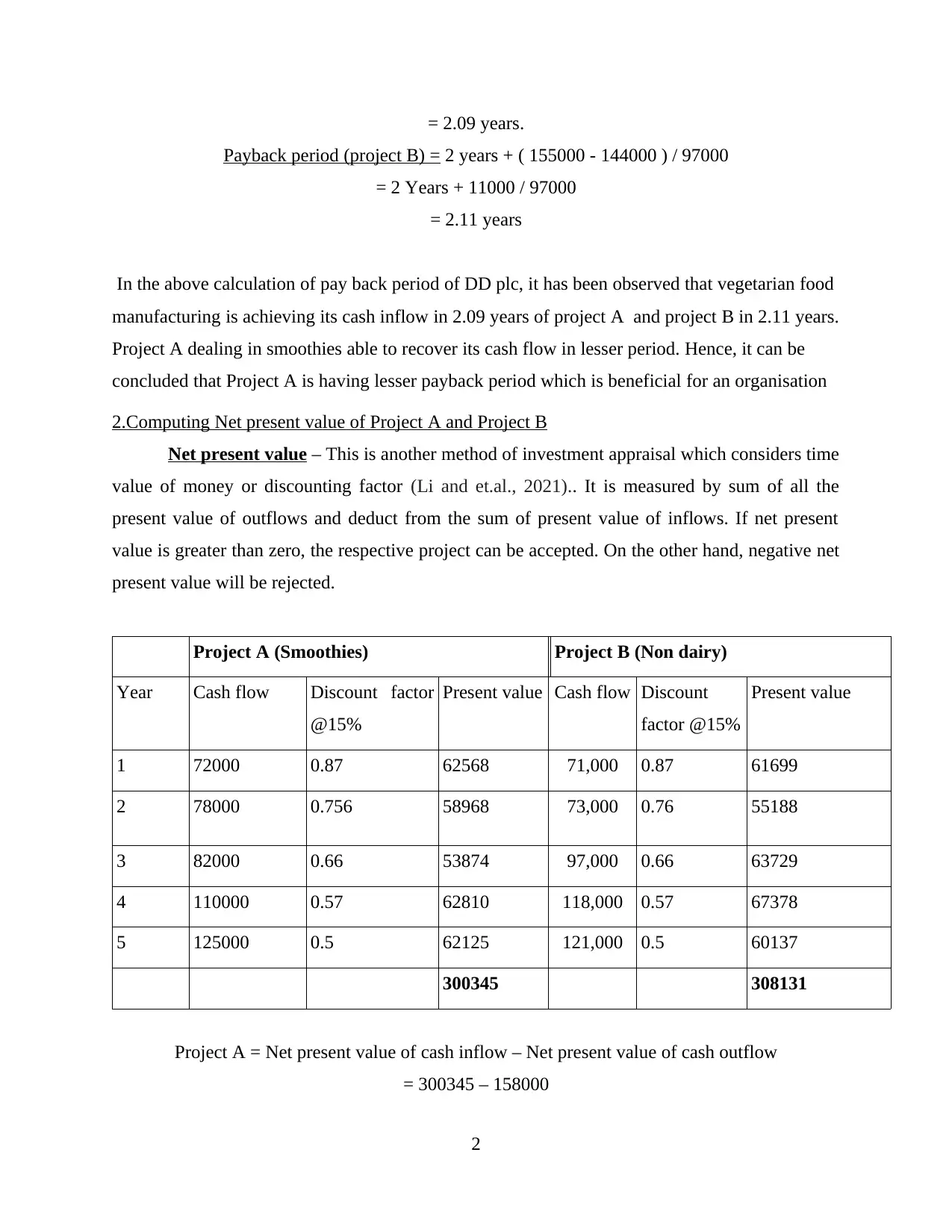
= 2.09 years.
Payback period (project B) = 2 years + ( 155000 - 144000 ) / 97000
= 2 Years + 11000 / 97000
= 2.11 years
In the above calculation of pay back period of DD plc, it has been observed that vegetarian food
manufacturing is achieving its cash inflow in 2.09 years of project A and project B in 2.11 years.
Project A dealing in smoothies able to recover its cash flow in lesser period. Hence, it can be
concluded that Project A is having lesser payback period which is beneficial for an organisation
2.Computing Net present value of Project A and Project B
Net present value – This is another method of investment appraisal which considers time
value of money or discounting factor (Li and et.al., 2021).. It is measured by sum of all the
present value of outflows and deduct from the sum of present value of inflows. If net present
value is greater than zero, the respective project can be accepted. On the other hand, negative net
present value will be rejected.
Project A (Smoothies) Project B (Non dairy)
Year Cash flow Discount factor
@15%
Present value Cash flow Discount
factor @15%
Present value
1 72000 0.87 62568 71,000 0.87 61699
2 78000 0.756 58968 73,000 0.76 55188
3 82000 0.66 53874 97,000 0.66 63729
4 110000 0.57 62810 118,000 0.57 67378
5 125000 0.5 62125 121,000 0.5 60137
300345 308131
Project A = Net present value of cash inflow – Net present value of cash outflow
= 300345 – 158000
2
Payback period (project B) = 2 years + ( 155000 - 144000 ) / 97000
= 2 Years + 11000 / 97000
= 2.11 years
In the above calculation of pay back period of DD plc, it has been observed that vegetarian food
manufacturing is achieving its cash inflow in 2.09 years of project A and project B in 2.11 years.
Project A dealing in smoothies able to recover its cash flow in lesser period. Hence, it can be
concluded that Project A is having lesser payback period which is beneficial for an organisation
2.Computing Net present value of Project A and Project B
Net present value – This is another method of investment appraisal which considers time
value of money or discounting factor (Li and et.al., 2021).. It is measured by sum of all the
present value of outflows and deduct from the sum of present value of inflows. If net present
value is greater than zero, the respective project can be accepted. On the other hand, negative net
present value will be rejected.
Project A (Smoothies) Project B (Non dairy)
Year Cash flow Discount factor
@15%
Present value Cash flow Discount
factor @15%
Present value
1 72000 0.87 62568 71,000 0.87 61699
2 78000 0.756 58968 73,000 0.76 55188
3 82000 0.66 53874 97,000 0.66 63729
4 110000 0.57 62810 118,000 0.57 67378
5 125000 0.5 62125 121,000 0.5 60137
300345 308131
Project A = Net present value of cash inflow – Net present value of cash outflow
= 300345 – 158000
2
Paraphrase This Document
Need a fresh take? Get an instant paraphrase of this document with our AI Paraphraser
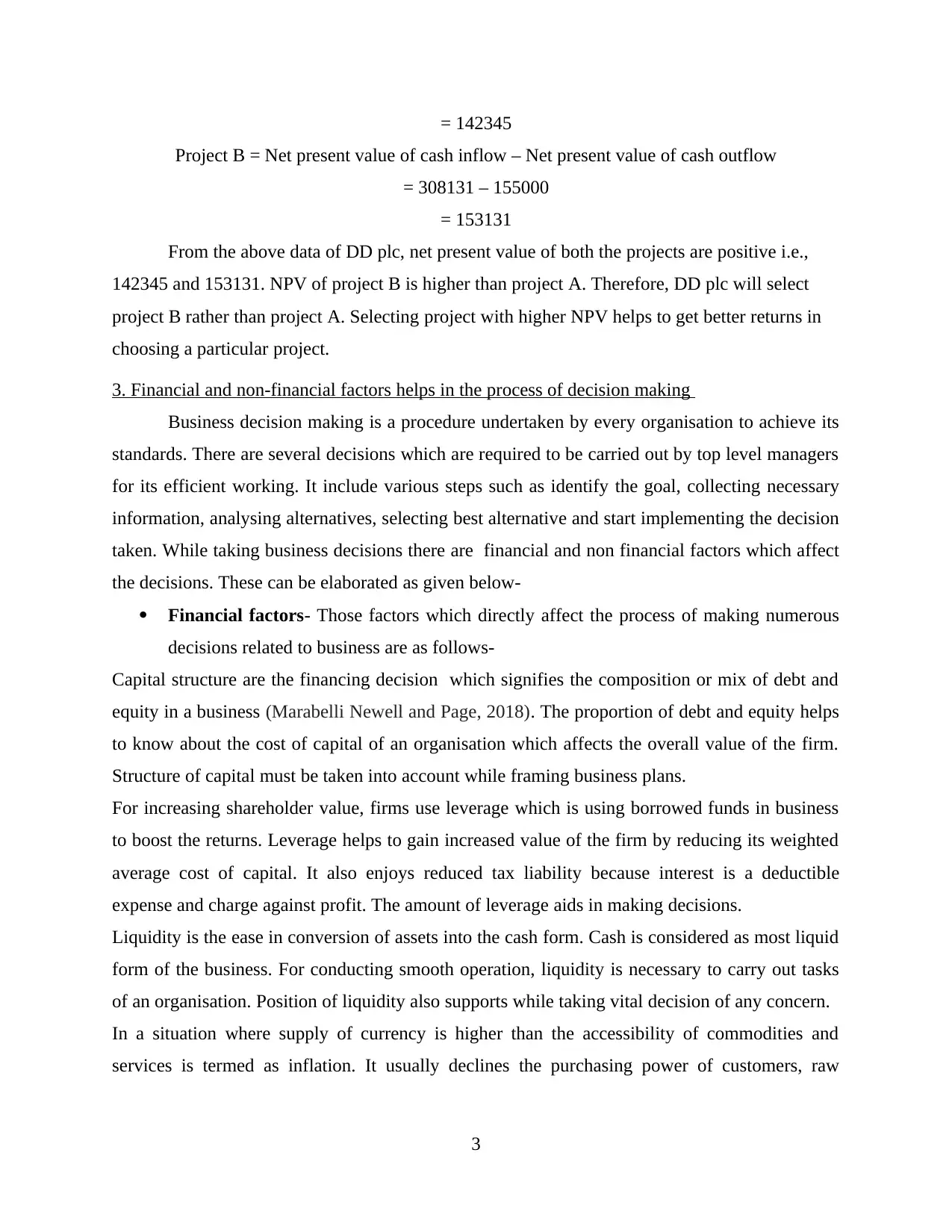
= 142345
Project B = Net present value of cash inflow – Net present value of cash outflow
= 308131 – 155000
= 153131
From the above data of DD plc, net present value of both the projects are positive i.e.,
142345 and 153131. NPV of project B is higher than project A. Therefore, DD plc will select
project B rather than project A. Selecting project with higher NPV helps to get better returns in
choosing a particular project.
3. Financial and non-financial factors helps in the process of decision making
Business decision making is a procedure undertaken by every organisation to achieve its
standards. There are several decisions which are required to be carried out by top level managers
for its efficient working. It include various steps such as identify the goal, collecting necessary
information, analysing alternatives, selecting best alternative and start implementing the decision
taken. While taking business decisions there are financial and non financial factors which affect
the decisions. These can be elaborated as given below-
Financial factors- Those factors which directly affect the process of making numerous
decisions related to business are as follows-
Capital structure are the financing decision which signifies the composition or mix of debt and
equity in a business (Marabelli Newell and Page, 2018). The proportion of debt and equity helps
to know about the cost of capital of an organisation which affects the overall value of the firm.
Structure of capital must be taken into account while framing business plans.
For increasing shareholder value, firms use leverage which is using borrowed funds in business
to boost the returns. Leverage helps to gain increased value of the firm by reducing its weighted
average cost of capital. It also enjoys reduced tax liability because interest is a deductible
expense and charge against profit. The amount of leverage aids in making decisions.
Liquidity is the ease in conversion of assets into the cash form. Cash is considered as most liquid
form of the business. For conducting smooth operation, liquidity is necessary to carry out tasks
of an organisation. Position of liquidity also supports while taking vital decision of any concern.
In a situation where supply of currency is higher than the accessibility of commodities and
services is termed as inflation. It usually declines the purchasing power of customers, raw
3
Project B = Net present value of cash inflow – Net present value of cash outflow
= 308131 – 155000
= 153131
From the above data of DD plc, net present value of both the projects are positive i.e.,
142345 and 153131. NPV of project B is higher than project A. Therefore, DD plc will select
project B rather than project A. Selecting project with higher NPV helps to get better returns in
choosing a particular project.
3. Financial and non-financial factors helps in the process of decision making
Business decision making is a procedure undertaken by every organisation to achieve its
standards. There are several decisions which are required to be carried out by top level managers
for its efficient working. It include various steps such as identify the goal, collecting necessary
information, analysing alternatives, selecting best alternative and start implementing the decision
taken. While taking business decisions there are financial and non financial factors which affect
the decisions. These can be elaborated as given below-
Financial factors- Those factors which directly affect the process of making numerous
decisions related to business are as follows-
Capital structure are the financing decision which signifies the composition or mix of debt and
equity in a business (Marabelli Newell and Page, 2018). The proportion of debt and equity helps
to know about the cost of capital of an organisation which affects the overall value of the firm.
Structure of capital must be taken into account while framing business plans.
For increasing shareholder value, firms use leverage which is using borrowed funds in business
to boost the returns. Leverage helps to gain increased value of the firm by reducing its weighted
average cost of capital. It also enjoys reduced tax liability because interest is a deductible
expense and charge against profit. The amount of leverage aids in making decisions.
Liquidity is the ease in conversion of assets into the cash form. Cash is considered as most liquid
form of the business. For conducting smooth operation, liquidity is necessary to carry out tasks
of an organisation. Position of liquidity also supports while taking vital decision of any concern.
In a situation where supply of currency is higher than the accessibility of commodities and
services is termed as inflation. It usually declines the purchasing power of customers, raw
3
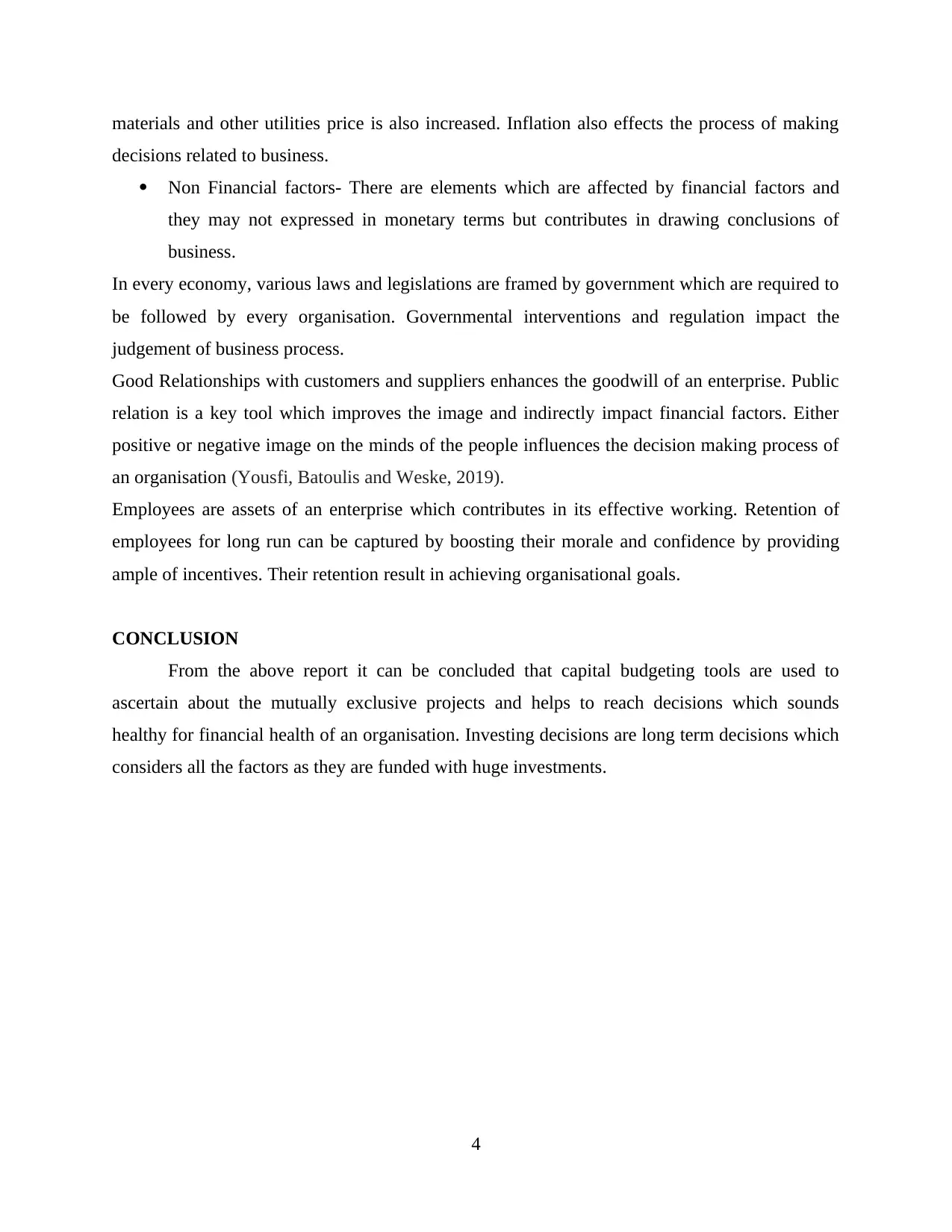
materials and other utilities price is also increased. Inflation also effects the process of making
decisions related to business.
Non Financial factors- There are elements which are affected by financial factors and
they may not expressed in monetary terms but contributes in drawing conclusions of
business.
In every economy, various laws and legislations are framed by government which are required to
be followed by every organisation. Governmental interventions and regulation impact the
judgement of business process.
Good Relationships with customers and suppliers enhances the goodwill of an enterprise. Public
relation is a key tool which improves the image and indirectly impact financial factors. Either
positive or negative image on the minds of the people influences the decision making process of
an organisation (Yousfi, Batoulis and Weske, 2019).
Employees are assets of an enterprise which contributes in its effective working. Retention of
employees for long run can be captured by boosting their morale and confidence by providing
ample of incentives. Their retention result in achieving organisational goals.
CONCLUSION
From the above report it can be concluded that capital budgeting tools are used to
ascertain about the mutually exclusive projects and helps to reach decisions which sounds
healthy for financial health of an organisation. Investing decisions are long term decisions which
considers all the factors as they are funded with huge investments.
4
decisions related to business.
Non Financial factors- There are elements which are affected by financial factors and
they may not expressed in monetary terms but contributes in drawing conclusions of
business.
In every economy, various laws and legislations are framed by government which are required to
be followed by every organisation. Governmental interventions and regulation impact the
judgement of business process.
Good Relationships with customers and suppliers enhances the goodwill of an enterprise. Public
relation is a key tool which improves the image and indirectly impact financial factors. Either
positive or negative image on the minds of the people influences the decision making process of
an organisation (Yousfi, Batoulis and Weske, 2019).
Employees are assets of an enterprise which contributes in its effective working. Retention of
employees for long run can be captured by boosting their morale and confidence by providing
ample of incentives. Their retention result in achieving organisational goals.
CONCLUSION
From the above report it can be concluded that capital budgeting tools are used to
ascertain about the mutually exclusive projects and helps to reach decisions which sounds
healthy for financial health of an organisation. Investing decisions are long term decisions which
considers all the factors as they are funded with huge investments.
4
⊘ This is a preview!⊘
Do you want full access?
Subscribe today to unlock all pages.

Trusted by 1+ million students worldwide

REFERENCES
Books and Journals
Bramley, R.G.V. and Ouzman, J., 2019. Farmer attitudes to the use of sensors and automation in
fertilizer decision-making: Nitrogen fertilization in the Australian grains
sector. Precision agriculture, 20(1), pp.157-175
Ebert, D.S., Fisher, B. and Gaither, K., 2018, January. Introduction to the Minitrack on
Interactive Visual Analytics and Visualization for Decision Making: Making Sense of
Big Data. In Proceedings of the 51st Hawaii International Conference on System
Sciences.
Li, M. and et.al., 2021. Political uncertainty and allocation of decision rights among business
groups: Evidence from the replacement of municipal officials. Pacific-Basin Finance
Journal, 67, p.101541.
Marabelli, M., Newell, S. and Page, X., 2018. Algorithmic Decision-Making in the US
Healthcare Industry. Marabelli, M., Newell, S., Page, X.,(2018). Algorithmic Decision-
Making in the US Healthcare Industry, Presented at IFIP, 8.
Yousfi, A., Batoulis, K. and Weske, M., 2019. Achieving business process improvement via
ubiquitous decision-aware business processes. ACM Transactions on Internet
Technology (TOIT), 19(1), pp.1-19.
5
Books and Journals
Bramley, R.G.V. and Ouzman, J., 2019. Farmer attitudes to the use of sensors and automation in
fertilizer decision-making: Nitrogen fertilization in the Australian grains
sector. Precision agriculture, 20(1), pp.157-175
Ebert, D.S., Fisher, B. and Gaither, K., 2018, January. Introduction to the Minitrack on
Interactive Visual Analytics and Visualization for Decision Making: Making Sense of
Big Data. In Proceedings of the 51st Hawaii International Conference on System
Sciences.
Li, M. and et.al., 2021. Political uncertainty and allocation of decision rights among business
groups: Evidence from the replacement of municipal officials. Pacific-Basin Finance
Journal, 67, p.101541.
Marabelli, M., Newell, S. and Page, X., 2018. Algorithmic Decision-Making in the US
Healthcare Industry. Marabelli, M., Newell, S., Page, X.,(2018). Algorithmic Decision-
Making in the US Healthcare Industry, Presented at IFIP, 8.
Yousfi, A., Batoulis, K. and Weske, M., 2019. Achieving business process improvement via
ubiquitous decision-aware business processes. ACM Transactions on Internet
Technology (TOIT), 19(1), pp.1-19.
5
1 out of 7
Related Documents
Your All-in-One AI-Powered Toolkit for Academic Success.
+13062052269
info@desklib.com
Available 24*7 on WhatsApp / Email
![[object Object]](/_next/static/media/star-bottom.7253800d.svg)
Unlock your academic potential
Copyright © 2020–2025 A2Z Services. All Rights Reserved. Developed and managed by ZUCOL.




